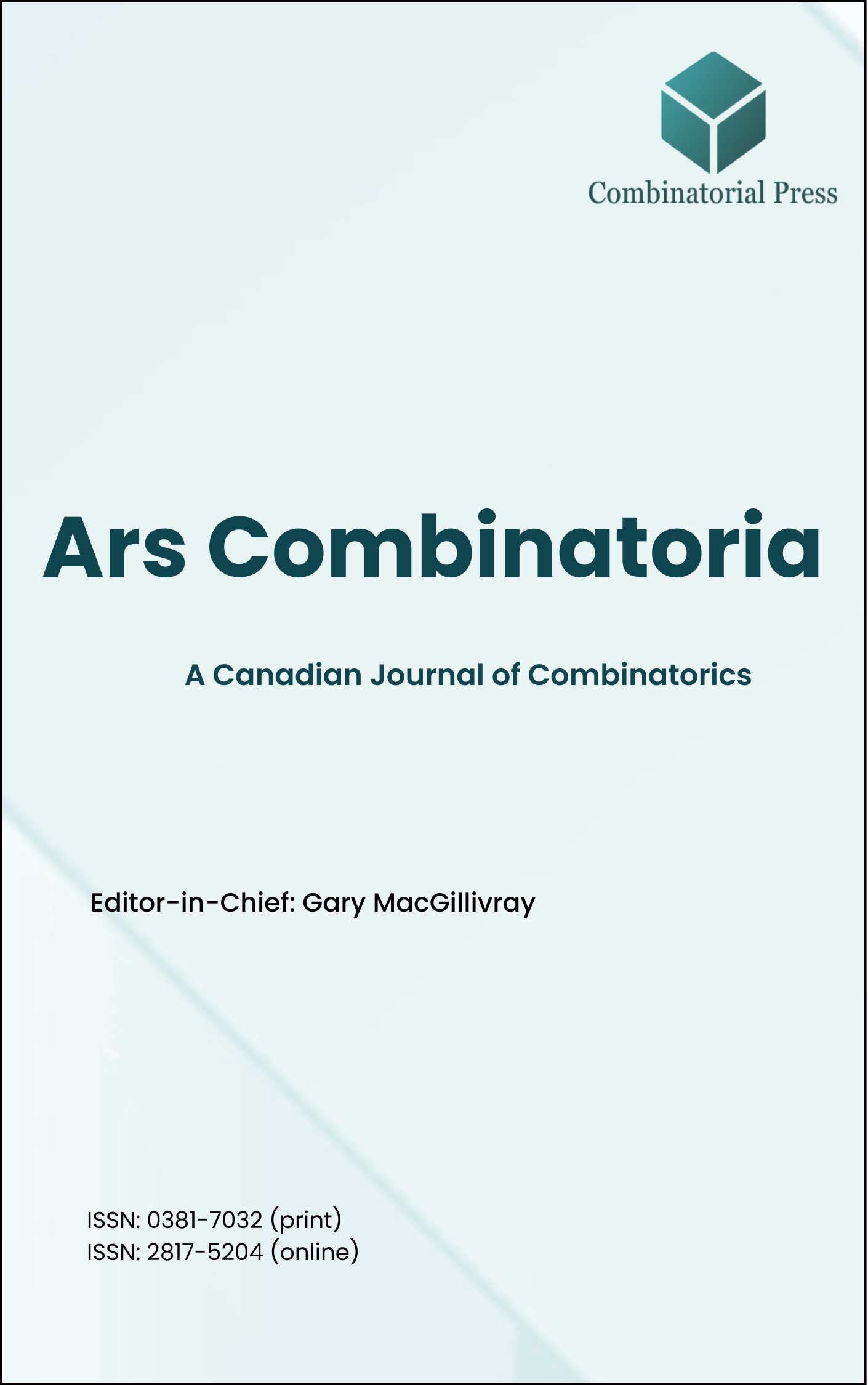
Ars Combinatoria
ISSN 0381-7032 (print), 2817-5204 (online)
Ars Combinatoria is the oldest Canadian Journal of Combinatorics, established in 1976. The journal is dedicated to advancing the field of combinatorial mathematics through the publication of high-quality research papers. From 2024 onward, it publishes four volumes per year in March, June, September and December. Ars Combinatoria has gained recognition and visibility in the academic community and is indexed in renowned databases such as MathSciNet, Zentralblatt, and Scopus. The Scope of the journal includes Graph theory, Design theory, Extremal combinatorics, Enumeration, Algebraic combinatorics, Combinatorial optimization, Ramsey theory, Automorphism groups, Coding theory, Finite geometries, Chemical graph theory but not limited.
Information Menu
- Research article
- Full Text
- Ars Combinatoria
- Volume 045
- Pages: 143-156
- Published: 30/04/1997
Let \(V\) be a finite set of order \(v\). A \((v, \kappa, \lambda)\) packing design of index \(\lambda\) and block size \(u\) is a collection of \(u\)-element subsets, called blocks, such that every \(2\)-subset of \(V\) occurs in at most \(\lambda\) blocks. The packing problem is to determine the maximum number of blocks, \(\sigma(v, \kappa, \lambda)\), in a packing design. It is well known that \(\sigma(v, \kappa, \lambda) \leq [\frac{v}{\kappa}[\frac{v-1}{\kappa-1}\lambda]] = \psi(v, \kappa, \lambda)\), where \([ x ]\) is the largest integer satisfying \(x \geq [ x ]\). It is shown here that \(\sigma(v, 5, 3) = \psi(v, 5, 3)\) for all positive integers \(v \geq 5\) with the possible exceptions of \(v = 43\) and that \(\sigma(v, 5, 3) = \psi(v, 5, 3)\) for all positive integers \(v = 1, 5, 9, 17 \pmod{20}\) and \(\sigma(v, 5, 3) = \psi(v, 5, 3) – 1\) for all positive integers \(v \equiv 13 \pmod{20}\) with the possible exception of \(v = 17, 29, 33, 49\).
- Research article
- Full Text
- Ars Combinatoria
- Volume 045
- Pages: 129-141
- Published: 30/04/1997
A graph with signed edges is orientation embedded in a surface when it is topologically embedded and a polygon preserves or reverses orientation depending on whether its sign product is positive or negative. We study orientation-embedding analogs of three facts about unsigned graph embedding: planarity is equivalent to having cographic polygon matroid, the polygon matroid of a graph determines the surfaces in which it embeds, and contraction preserves embeddability of a graph in a surface.
We treat three matroids of a signed graph. Our main results:
For a signed graph which is orientation embeddable in the projective plane, the bias and lift matroids (which coincide) are cographic.
Neither the bias nor lift nor complete lift matroid determines the surfaces in which a signed graph orientation embeds.
Of the two associated contractions of signed edges, the bias contraction does not preserve orientation embeddability but the lift contraction does.Thus the signed graphs which orientation embed in a particular surface are characterizable by forbidden lift minors.
- Research article
- Full Text
- Ars Combinatoria
- Volume 045
- Pages: 109-127
- Published: 30/04/1997
A graph \(G\) having \(7\) vertices is called a chordal ring if its vertices can be arranged in a Hamiltonian cycle \(0, 1, 2, \ldots, n-1\) and there is a proper divisor \(d\) of \(n\) such that for all vertices \(i\) and \(j\), \(i\) is adjacent to \(j\) in \(G\) if and only if \(i+d\) is adjacent to \(j+d\) (addition modulo \(n\)). We consider here the efficacy of coloring the vertices of such a graph by the greedy algorithm applied to the vertices in the order of their appearance on the cycle. For any positive integer \(n\), let \(\Sigma_n\) denote the set of all permutations of the set \(\{1, 2, \ldots, n\}\) together with the adjacency relation \(\sim\) defined as follows: for \(\sigma\) and \(\tau\) in \(\Sigma_n\), \(\sigma \sim \tau\) if and only if there is an integer \(i\) such that \(\sigma-i = \tau-i\). (Here \(\sigma-i\) denotes the permutation of length \(n-1\) obtained by deleting \(i\) from \(\sigma\).) In this paper, we study some of the properties of the graph \((\Sigma_n, \sim)\). Two of the results obtained are the following:
(i) \((\Sigma_n, \sim)\) is a chordal ring for every positive integer \(n\);
(ii) the chromatic number of \(\Sigma_5\) is \(5\) but the greedy algorithm colors \(\Sigma_5\) in \(9\) colors.
- Research article
- Full Text
- Ars Combinatoria
- Volume 045
- Pages: 97-108
- Published: 30/04/1997
A division of a cake \(X = X_1 \cup \cdots \cup X_n\) among \(n\) players with associated probability measures \(\mu_1, \ldots, \mu_n\) on \(X\) is said to be:
(a) exact in the ratios of \(\alpha_1 : \alpha_2 : \cdots : \alpha_n\) provided whenever \(1 \leq i, j \leq n\), \(\frac{\mu_i(X_j)} { \mu_1(X)} = \alpha_i / (\alpha_1 + \cdots + \alpha_n)\)
(b) \(\epsilon\)-near exact in the ratios \(\alpha_1 : \alpha_2 : \cdots : \alpha_n\) provided whenever \(1 \leq i, j \leq n\), \(|\frac{\mu_i(X_i)}{\mu_1(X_1)} + \cdots +\frac {\alpha_j}{\alpha_1 + \cdots + \alpha_n}| < \epsilon\)
(c) envy free in ratios \(\alpha_1 : \alpha_2 : \cdots : \alpha_n\) provided whenever \(1 \leq i, j \leq n\), \(\frac{\mu_i(X_i)}{\mu_i(X_j)} \geq \frac{\alpha_i}{\alpha_j}\).
A moving knife exact division is described for two players and it is shown there can be no finite exact algorithm for \(n \geq 2\) players. A bounded finite \(\epsilon\)-near exact algorithm is given which is used to produce a finite envy free, \(\epsilon\)-near exact algorithm.
- Research article
- Full Text
- Ars Combinatoria
- Volume 045
- Pages: 87-95
- Published: 30/04/1997
We study bounds on the cardinality of sum-distinct sets of \(n\)-vectors with nonnegative integral components under component-wise real-number addition. A subclass of sum-distinct sets induced by an \(n \times n\) integral matrix of rank \(n\) is studied as well.
- Research article
- Full Text
- Ars Combinatoria
- Volume 045
- Pages: 33-76
- Published: 30/04/1997
- Research article
- Full Text
- Ars Combinatoria
- Volume 045
- Pages: 29-32
- Published: 30/04/1997
A family of subsets satisfies the Helly property when every subfamily of it, formed by pairwise intersecting subsets, has a common element. A graph is clique-Helly when the family of subsets of vertices which induces the maximal cliques of the graph satisfies the Helly property. We describe a characterization of clique-Helly graphs, leading to a polynomial time algorithm for recognizing them.
- Research article
- Full Text
- Ars Combinatoria
- Volume 045
- Pages: 13-28
- Published: 30/04/1997
A semi-complete bigraph \(G\) has adjacency matrix
\[A = \begin{pmatrix} 0 & B \\ B^T & 0 \end{pmatrix},\]
where \(B + B^T = J – I\), so \(B\) is the adjacency matrix of a tournament \(T\) corresponding to \(G\). We determine algebraic and structural properties of this class of graphs. In particular, we obtain a condition equivalent to the connectedness of a semi-complete bigraph; moreover we determine characterizations of semi-complete bigraphs having 4 distinct eigenvalues in the case of \(G\) regular or \(A\) irreducible. In particular, a regular semi-complete bigraph has 4 distinct eigenvalues if and only if it corresponds to a doubly regular tournament.
- Research article
- Full Text
- Ars Combinatoria
- Volume 045
- Pages: 3-12
- Published: 30/04/1997
Let \(D\) be an asymmetric digraph and \(A\) a finite group. We give a formula for the characteristic polynomial of a cyclic \(A\)-cover of \(D\). This is a generalization of a formula for the characteristic polynomial of a regular covering of a graph. Furthermore, we discuss cyclic abelian covers of \(D\).
- Research article
- Full Text
- Ars Combinatoria
- Volume 045
- Pages: 169-179
- Published: 30/04/1997
We define an almost-convex polygon as a non-convex polygon in which any two vertices see each other inside the polygon unless they are not adjacent and belong to a chain of consecutive concave vertices. Using inclusion-exclusion techniques, we find formulas for the number of triangulations of almost-convex polygons in terms of the number and position of the concave vertices. We translate these formulas into the language of generating functions and provide several simple asymptotic estimates. We also prove that certain balanced configurations yield the maximum number of triangulations.





